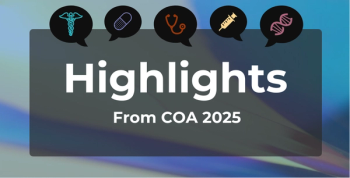
NCCN Panel Digs Into Reality of CAR T-Cell Reimbursement
A panel during the opening day of the 2019 National Comprehensive Cancer Network Annual Conference examined the recent process for National Coverage Determination for chimeric antigen receptor (CAR) T-cell therapy and what it means for the future of innovative treatments.
Days after the comment deadline for CMS’ plan to reimburse chimeric antigen receptor (CAR) T-cell therapy, leading clinicians, a patient advocate, and the payer that triggered the process laid bare the truth of what’s happening with this therapy: it’s saving lives, but leading cancer centers are losing money on Medicare patients, and that’s not sustainable.
The panel discussion during the first day of the 2019 National Comprehensive Cancer Network (NCCN) Annual Meeting, held in Orlando, Florida, focused on CAR T-cell therapy as the centerpiece for the broader problem with innovative cancer treatments. As moderator Clifford Goodman, PhD, of the Lewin Group, described it, complex therapies with entirely new mechanisms of action, “are prompting, necessarily, a change in how we pay for this stuff.”
So far, however, the old way of paying for treatment, and Medicare in particular, has not kept pace. An early value-based agreement to cover the cost of the first approved treatment was scrapped, and following a request from UnitedHealthcare, CMS embarked a year ago on a National Coverage Determination (NCD) to come up with a reimbursement policy that would affect CAR T-cell therapy across the country.
The centerpiece of
Clinicians on the panel agreed that cancer centers cannot lose money indefinitely on treatment processes that cost six figures just for the therapy alone—$475,000 for tisagenlecleucel (Kymriah) in the pediatric acute lymphoblastic leukemia indication, and $373,000 for that drug and axicabtagene ciloleucel (Yescarta) in diffuse large B-cell lymphoma. Goodman’s poll of the panel put the total cost of treatment between $800,000 and $1.5 million, but Frederick L. Locke, MD, of Moffitt Cancer Center, who before the panel had presented a case involving a patient from the ZUMA-1 trial, said Medicare’s hospital billing codes were not designed for the care required in administering a therapy like CAR T-cell therapy, which brings significant side effects. Moffitt has designed an extensive patient and caregiver education program to prepare the families for what to expect.
Before the NCD process began, Florida was making progress in reimbursement with its regional Medicare Administrative Contractor, Locke said. As it exists today, “The process of paying for it doesn’t allow Medicare to reimburse enough for hospitals to pay the therapy,” he said “How is that going to work? We can only do this for so long where we’re not getting fully paid.”
“If it’s not figured out soon,” he warned,” We will not be able to do this for Medicare patients.”
Impetus for the NCD Process
Goodman waited a bit to bring Jennifer Malin, MD, PhD, senior medical director of oncology and genetics for UnitedHealth Group, into the conversation. UnitedHealth Group’s letter requesting an NCD prompted CMS to start the process, and Goodman asked her to explain the thinking. He noted the letter did not mention cost. Malin explained while that is true, traditional commercial contracts don’t pay manufacturers—they pay providers based on a percentage of therapy cost, and that will not work with CAR T-cell therapy.
Malin said UnitedHealth was motivated by the unique nature of the therapy and the questions that would arise if the regional MACs came to different decisions. What if a patient from Texas went to Moffitt in Florida for care?
But a bigger issue was the prediction that CAR T-cell therapy would quickly expand beyond its approved uses, and cancer centers would want to use it off label, with justification. As a national payer, UnitedHealth felt it needed an NCD to address this. “How we do ensure it is consistently applied?” she said. “As a national health plan, we don’t want to see inequities based on where (people) live.”
“That is why we’re still in the midst of an inflection point,” Goodman replied, explaining that many do not realize that reimbursement decisions are often made at the level of the MACs not Medicare. For a pharmaceutical company, an NCD can be “risky business,” he said. If the answer is “no,” it’s no everywhere, but if it’s “yes,” then its yes everywhere, Goodman explained.
The Importance of PROs
And that’s the process that CAR T-cell therapy has been going through over the past year. An
Said Malin, “We want to make sure patients are not just surviving but thriving.”
Patient advocate and cancer survivor Stephanie Joho agreed that PROs are essential and went a step further, saying that patients in clinical trials must be viewed as “co-investigators,” because sometimes the adverse effects patients think are important are overlooked. These could be important in 10 to 20 years, she said.
Sweetenham added, “Don’t underestimate the importance of PROs,” as they not only indicate quality of life, but may also predict survival.
Lalan Wilfong, MD, of Texas Oncology, said the financial challenges that others described become even trickier in community practice, because revenue sources like grant funding are often unavailable. As CAR T-cell therapy moves to the community setting, a challenge will be educating physicians about the side effects that patients experience. Working with patients with high deductible plans is always a challenge—January is always a stressful month, he said—and community practices become expert in navigating these hurdles with their patients.
Just where to keep a CAR T-cell treatment in a community practice, given its cost, has been a topic of discussion, given the buy-and-bill business model. “It will be interesting to see what happens if a drug that expensive becomes available.”
Newsletter
Stay ahead of policy, cost, and value—subscribe to AJMC for expert insights at the intersection of clinical care and health economics.







































